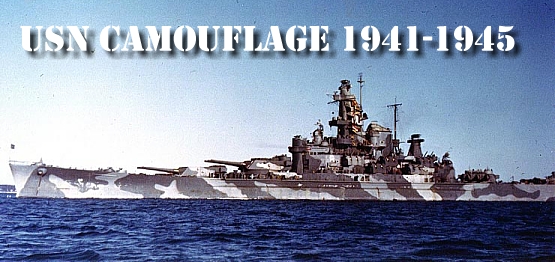
An online database of camouflage used by
United State Naval Warships during WWII
|
|
|
The
Development of Naval Camouflage 1914 - 1945 By
Alan Raven (Article reprinted courtesy of Plastic Ship Modeler Magazine issue #97/2) 35.
There is much that I might profitably do here, but it may be that I can be more
useful back in Washington, and I am asking to he detached at an early date.
Everett Warner. The
above report was followed up in December by a memo from the Camouflage section
to Commander in Chief US Fleet. The
relevant part of the memo is quoted below. 1.
The majority of ships in the Pacific Fleet including the combatant ships are
painted in the course and type deception patterns of Measures 31, 32 and 33.
Landing craft, submarines, and a few other types are excepted; these being
painted strictly for concealment rather than for deception.
Several combatant ships and many auxiliaries remain painted in Navy Blue,
Measure 21, due primarily to a lag in receipt of instructions and paint. 2.
Extensive studies were made of the ships in the Central and South Pacific Ocean
areas. These included (a)
observation by Fleet and Bureau personnel, (b) an analysis of questions aired by
81 officers interviewed in the Fleet, and (c) an analysis of replies to
ComServPac's letter of enquiry dated 2 August 1944. These are summarized under A, B, and C as follows: A.
Observations 1
) All ships were too dark most of the time, 5-0 was better then 5-N. 2.
) High visibility conditions were predominant so that deception was effective
and low visibility efforts on battleships, cruisers, and carriers entirely
futile during all daylight hours. 3.)
The lightest shade of paint used (Pale Gray 5-P) and the darkest (Dull Black)
were both conspicuous and unnecessary for deception or low visibility.
Black and Navy Blue were the worst offenders of visibility. B.
Interview questionnaires concerning pattern Measures 31, 32, 33. 1.)
80% wrote that patterns created target angle deception. 2.)
69% answered that patterns created type deception. 3.)
38% Patterns decreased visibility.
22% Patterns increased visibility.
10% Both increased and decreased.
7% Answered that patterns had no effect upon
visibility of ships. 4.
The torpedo bomber was named Pacific Enemy Number One, Snooper aircraft were put
in second place, with submarines a very close third. Enemy surface ships were rated fourth, and the high angle
dive bomber relegated to fifth place. C.
33 answers to CoMServPac Conf. Ltr., Serial 02164, dated 2 August 1944, states; 1.)
69% state pattern measures are effective.
31% state pattern measures are ineffective. 2.)
52.6% state the measures are suitable.
47.4% state the measures are unsuitable. 3.)
A wide variety of conflicting opinion was expressed by Pacific Fleet forces on
the suitability of any one method of painting to meet the tactical situations
that might arise. Designs planned
for and effective at distant and intermediate ranges were frequently judged by
their conspicuousness close aboard, but in general the Fleet comments were very
constructive and helpful. 3.
Measure 21 is now proposed for a large group of ships and in some cases
ComServPac has directed its application in East Coast yards. This measure is
known to increase the visibility of ships in the Pacific ocean areas.
Likewise Measure 22 is requested to replace pattern measures although it
has been shown by observation, test, and Fleet opinion to he less effective.
On the other hand, the Bureau has already embarked upon a program of
modification it has every right to believe sound since it is based on
observations and a broad Fleet opinion. The
changes and modifications proposed by the Bureau are listed in detail in
Enclosure (J). 4.
The Bureau of Ships therefore requests the Commander in Chief to modify the
policy of 1941 which placed the power of selection of camouflage measures in the
hands of Fleet and Force Commanders. It is recommended that the preparation,
selection, and distribution of Ship Camouflage Instructions be the
responsibility of the Bureau of Ships. Dayton R.E. Brown, Lt. Comdr. USNR.
|